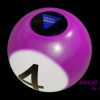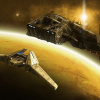Home › David_cgc › Best Of...
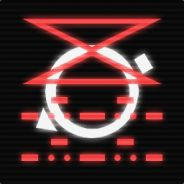
Greetings!
Welcome to Scifi-Meshes.com! Click one of these buttons to join in on the fun.
David_cgc
About
- Username
- David_cgc
- Joined
- Visits
- 530
- Last Active
- Roles
- Member
- Points
- 360
- Posts
- 18
- After Effects
- After Effects
- Lightwave 3D
- Lightwave 3D
- Photoshop
- Photoshop
- Substance Painter
- Substance Painter
- ArtStation
- @davidcgc
- Homepage
- www.gian-cursio.net
- IMDB
- Profile
- Vimeo
- user5879476
- Youtube
- Profile
- Badges
- 7
-
David's Stargate 3D Stuff
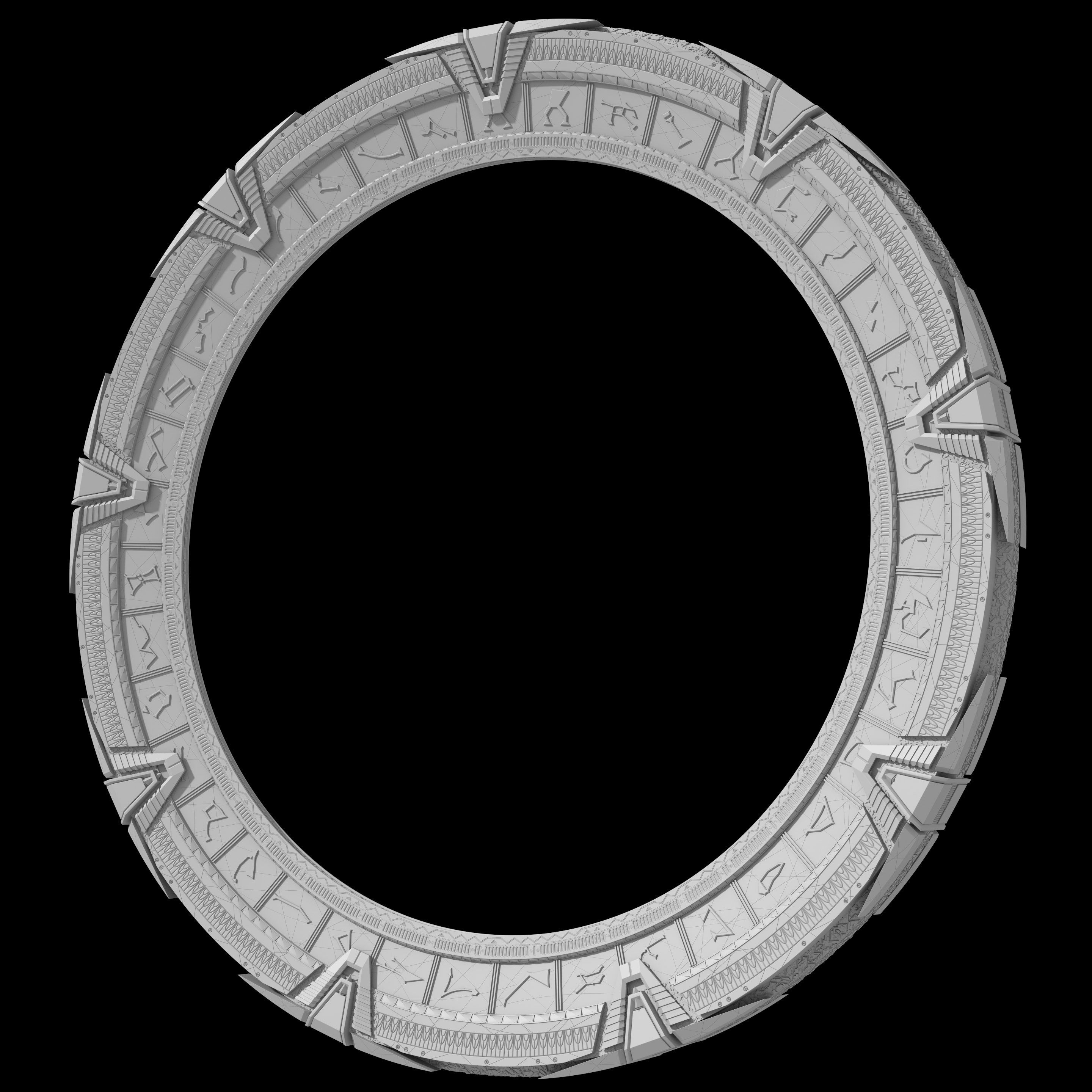
I've drawn and extruded the SG-1 version of the inner ring glyphs. There are a couple other variations visible, as well. Some (but not all) of the patterns on the outer rim are rotated 180 degrees from their orientation on the movie version. I also noticed I misaligned the row of large blocks above the glyph track. That's been corrected on the movie version, as well, but I'm not going back and re-rendering all those images again.
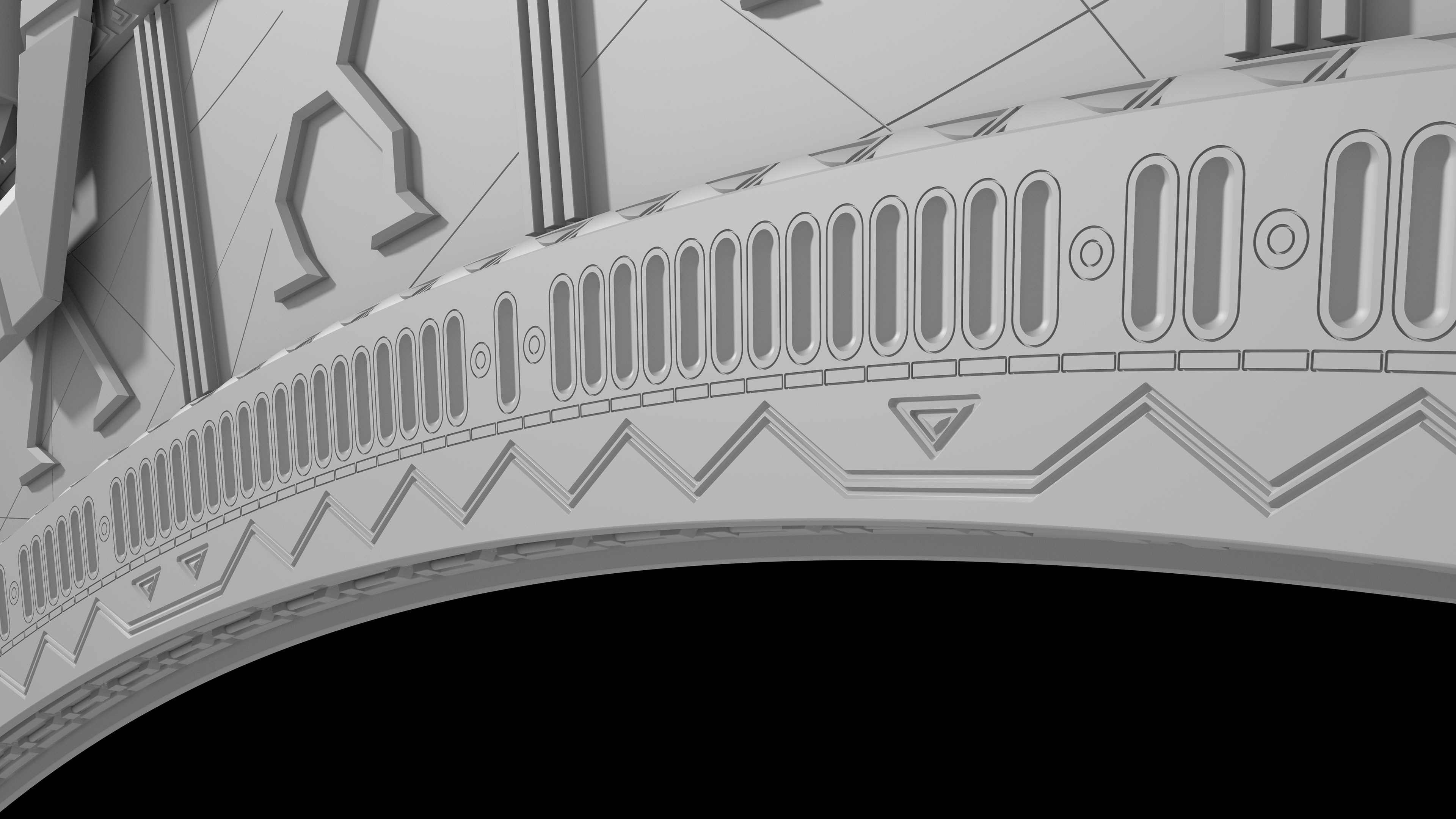
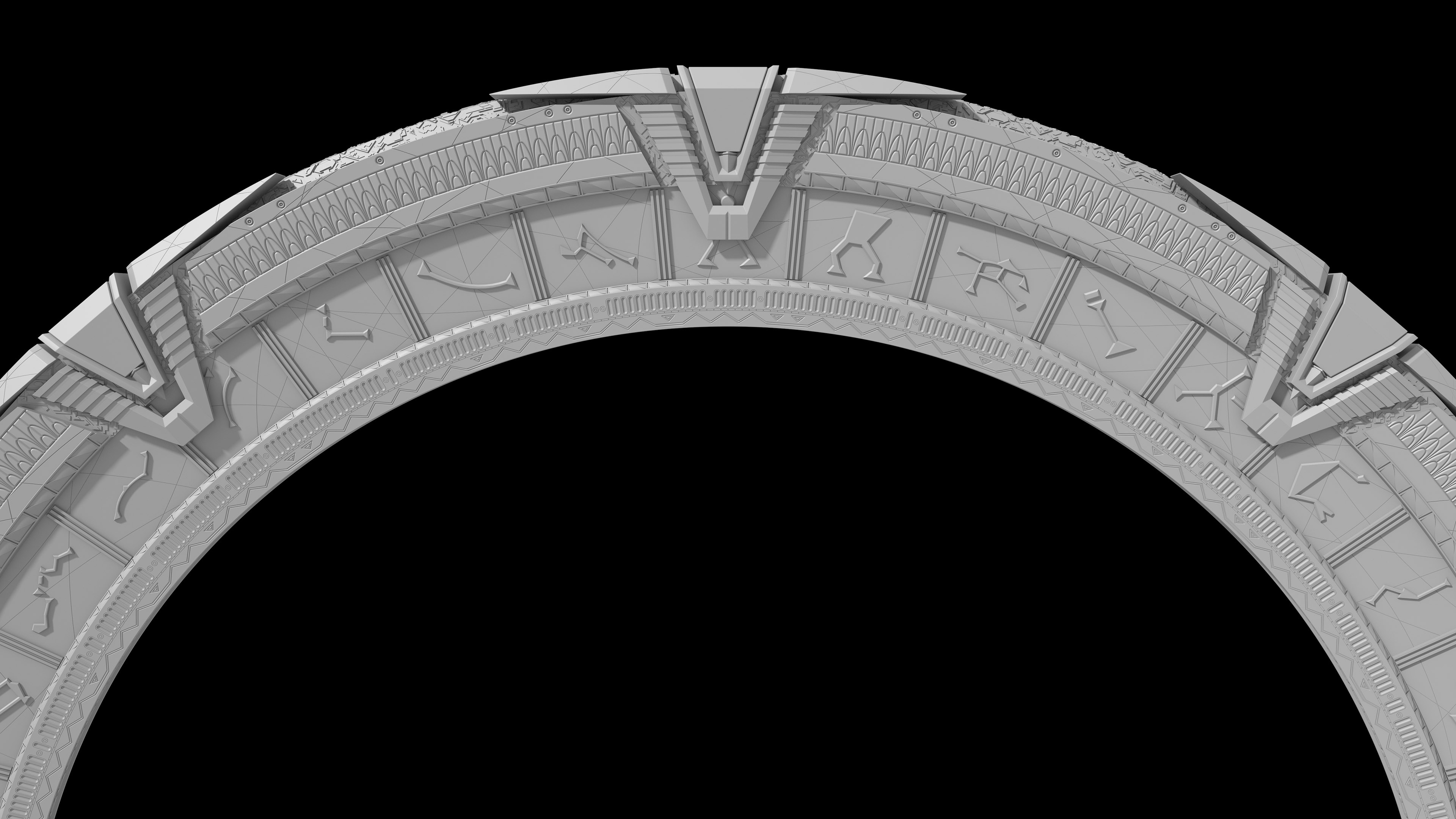
I decided to keep the chevrons and wings in the arrangement they had on the movie version, rather than moving the chevrons higher and the wings closer together (and drooping), as they were when on the SG-1 setpiece. I'll make that change on the Atlantis version, though, since for that one, the slots the chevrons were mounted in were smaller, and other aspects of the setpiece were realigned to fit with the higher chevrons.
And now we come to the whole reason I keep making stargate models, the point of origin symbols. This image has the official origin symbols used on the show and licensed tie-ins.
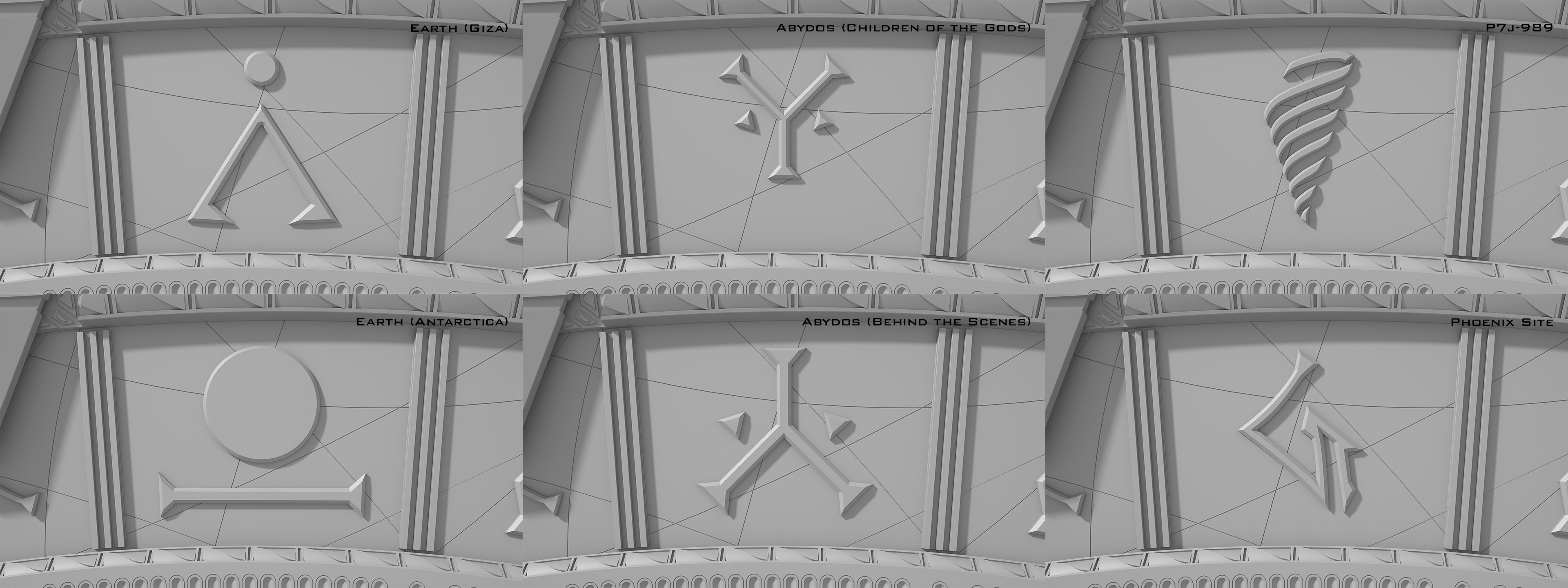
There are two versions of the Abydos symbol because we only saw it on the actual stargate once, on a laptop screen in the original cut of the pilot, where it was tiny, off-center, upside-down, and squished horizontally (even I have my limits). I think this looks silly, but it wasn't hard to do with what I already had, so I threw it in. The "behind the scenes" version is based on how the symbol appears in a glyph panel supposedly from the production of the show. While I don't think it was ever used on-screen, in size and orientation, it's a lot more like how you'd expect the glyph to look, so I consider that the "default" Abydos ring, and the other version an alternative for canon hardliners.
The "Phoenix Site" and it's associated origin symbol are from the upcoming Stargate SG-1 tabletop RPG from Wyvern Gaming.
Next up, more origin symbols, based on the movie versions of the glyphs I've already made. There are about 15 other planets that have had visible origin symbols on the show, but they were all one of the normal "address" glyphs, so I figure having new glyphs (or repurposed movie glyphs) that are based on the ones used by the show is a fair compromise, plus that leaves another 24 that can be used for any other arbitrary planets. Or people could just do the sensible thing and rotate the ring so the origin symbol is below the ramp and can't be seen. Anyway, once that's done, I'm going to start doing lighting and surfacing tests for the chevrons, see what techniques look best and render fastest. Then comes texturing, rig up some setup and demo scenes, then the Atlantis 'gate so I don't have time to forget how I did everything, then, either effects or environments. -
Comparing Notes, Animated

Around the time my image “Comparing Notes” was featured in the 2016 edition of the Ships of the Line calendar, I worked up an animated version, inspired by the “Active Duty” compilations of animated versions of various SotL images. The premise for the golden lighting of the original image was that it was captured at the moment the ships passed out of the shadow of Earth, and were briefly lit by dawn-colored sunlight passing through the atmosphere, the same reason the moon turns red during a lunar eclipse (and an effect that you can see happen on a real-life spacecraft in this video of the International Space Station), so I set up the animation to start in darkness, and then have a sudden dawn followed by bright white direct sunlight. I fiddled with it from time to time, incorporating the interiors I modeled for Dennis Bailey’s Enterprise and adding a cameo by the Endeavour’sbuddy-ship, the U.S.S. Sagittarius. However, I eventually put the animation aside, since my computer at the time would’ve taken forever to render it.
Time marched on, and Lightwave revamped its render engine, meaning older scenes would need to have their lighting and texturing adjusted to work in the new renderer. More recently, older versions of Lightwave on the Mac began having graphical glitches as newer versions of the OS came out, first having interface icons fail to render, and then drop-down menus, making the program nearly unusable. While I use the current version of Lightwave for my day-to-day, I did keep the last version that used the old render engine around to render my many, many old scenes and models when I didn’t have time to update them. But with this glitch, I remembered my old Comparing Notes animation, and decided it was now or never. A few months of rendering later (give or take a few breaks for video games and Stargate showcase renders), it came out.
The scene is pretty much exactly the way I left it five years ago, so it has some vintage quirks (for instance, it’s from before I started using linear workflow), but I did incorporate one modern touch. NASA released high-resolution HDR full-sky spherical map in 2020. I loaded the old scene into Lightwave 2020 so I could work with it (all I needed was the camera move, not the actual models and lights), and rendered the stars using that image map as a separate layer for later compositing. I also played with the exposure and grain layers in After Effects, creating the effect that the camera was compensating as the scene brightened. It worked really well. I’ve been disappointed when attempting to use sphere maps for stars in the past, but it looks like a 32k HDR is enough resolution to get the job done (the 64k version crashed Lightwave whenever I tried to load it), and can be adjusted to show individual stars against black, or the cloudy band of the Milky Way, depending on exposure. And there’s even a version with the foreground stars randomized so it can be used as a background in images set in distant star systems, avoiding the Battlestar Galactica problem of recognizable constellations showing up where they shouldn’t be, so this will be my solution for background stars in space images in the future.
Credits:
U.S.S. Endeavour and Drydock by Prologic9
U.S.S. Enterprise by Dennis Bailey
Shuttlecraft by Raul Mamoru
Travel Pod by Matthew Parker & Henry Gibbens
Tug by Jason Tinsley
Workbee by Unknown
U.S.S. Sagittarius by David Gian-Cursio
Music is “Remembering Data / The Enterprise” by Jerry Goldsmith from Star Trek: Nemesis -
David's Stargate 3D Stuff
I've finished up modeling on the Atlantis stargate. The main differences from the last update is the addition of the engraved groove patterns, and I got some last-minute reference for the back of the ring, so I was able to correct the part of the chevron slot I couldn't make out before.
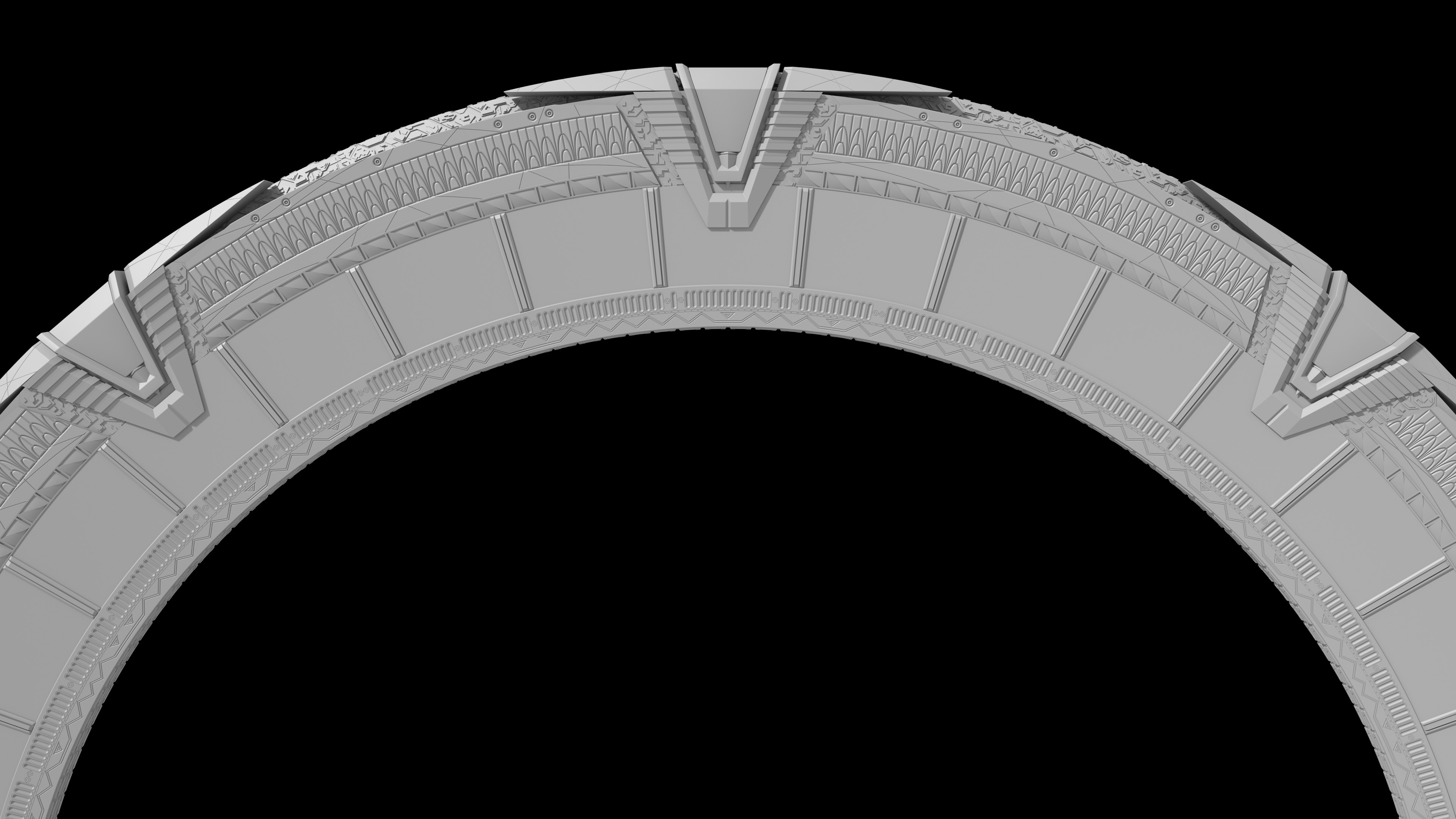
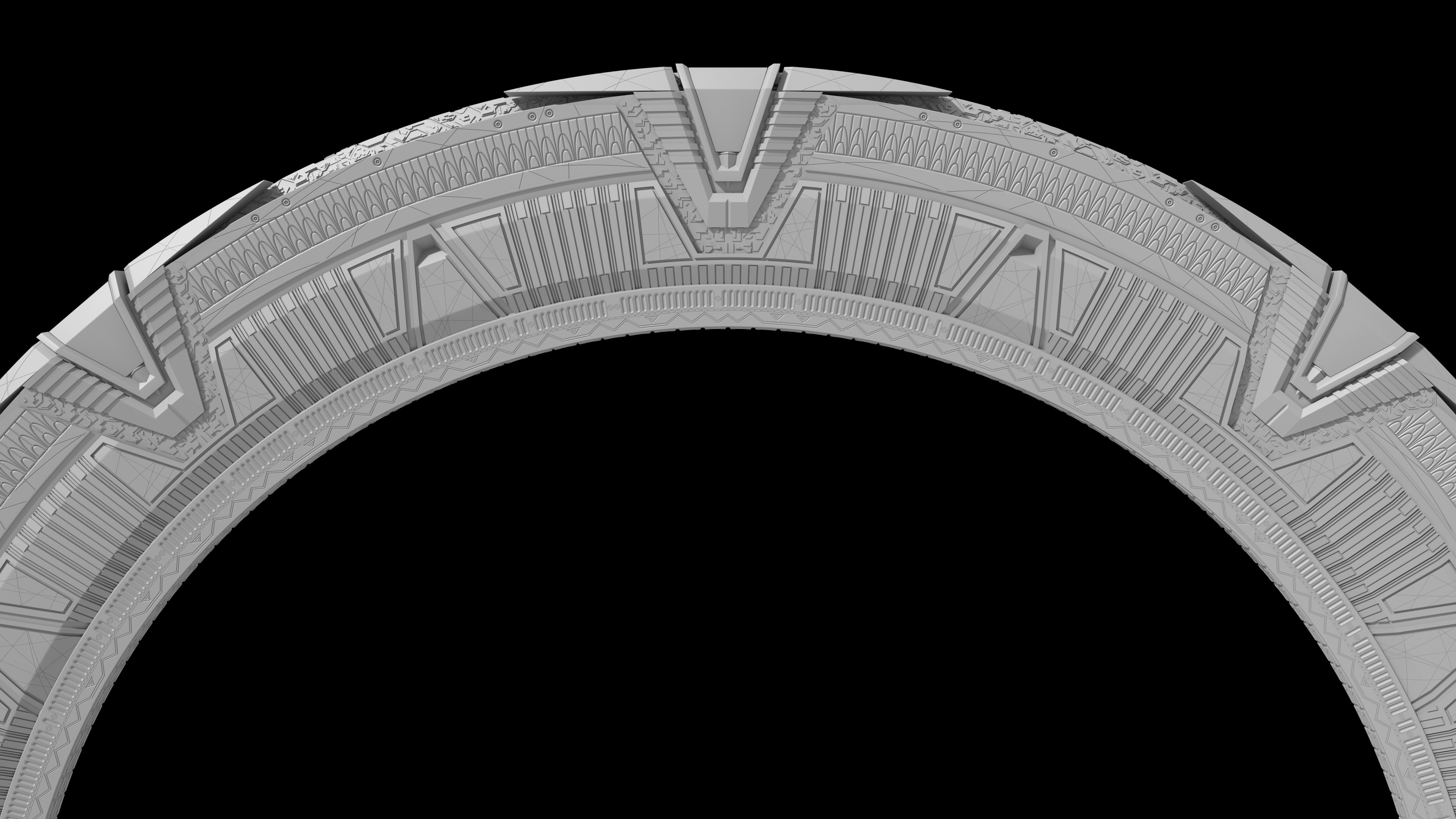
In preparation for texturing and lighting, I've also done a couple tests:

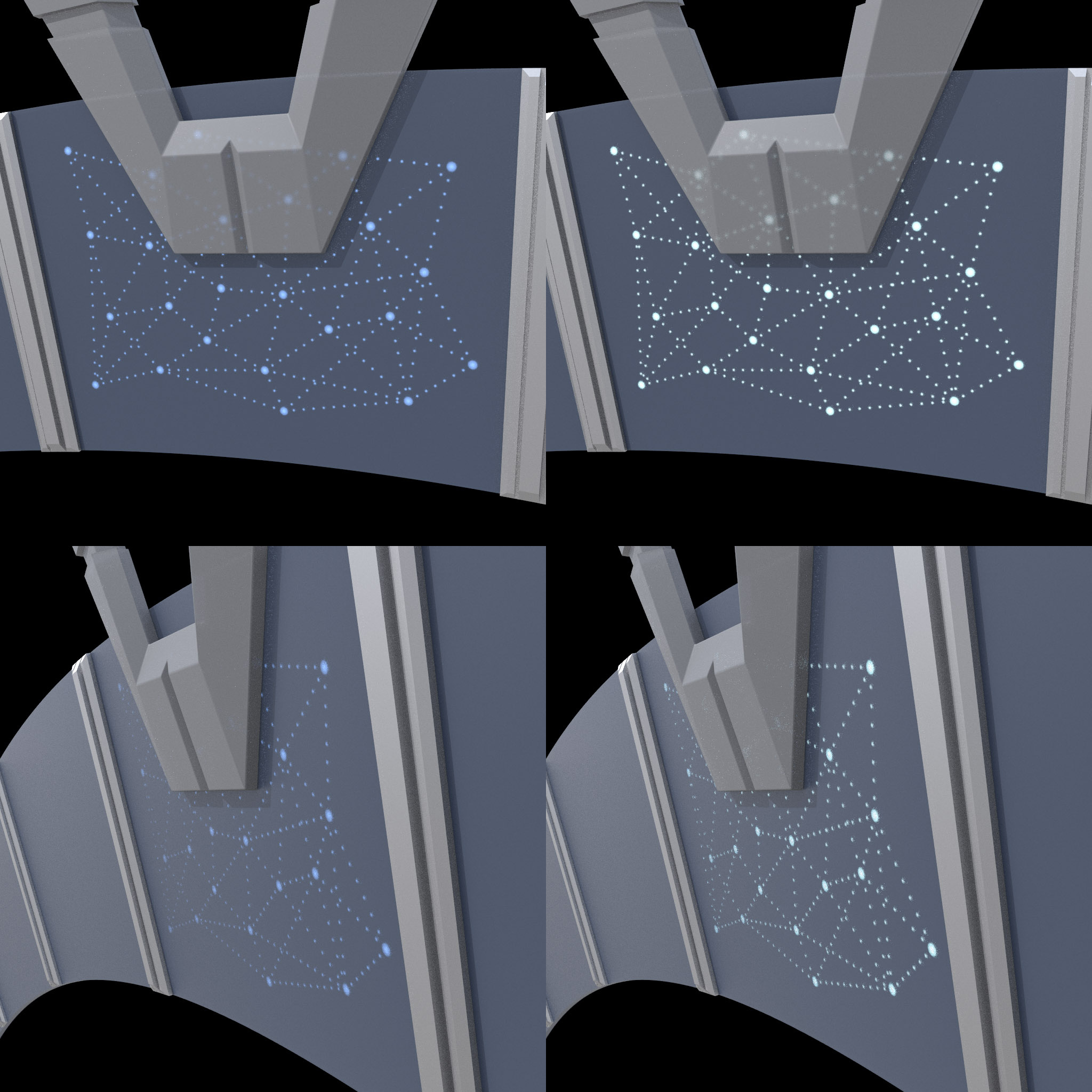
And, because the texturing is frightening, I've also done the glyphs. Both the Pegasus glyphs:
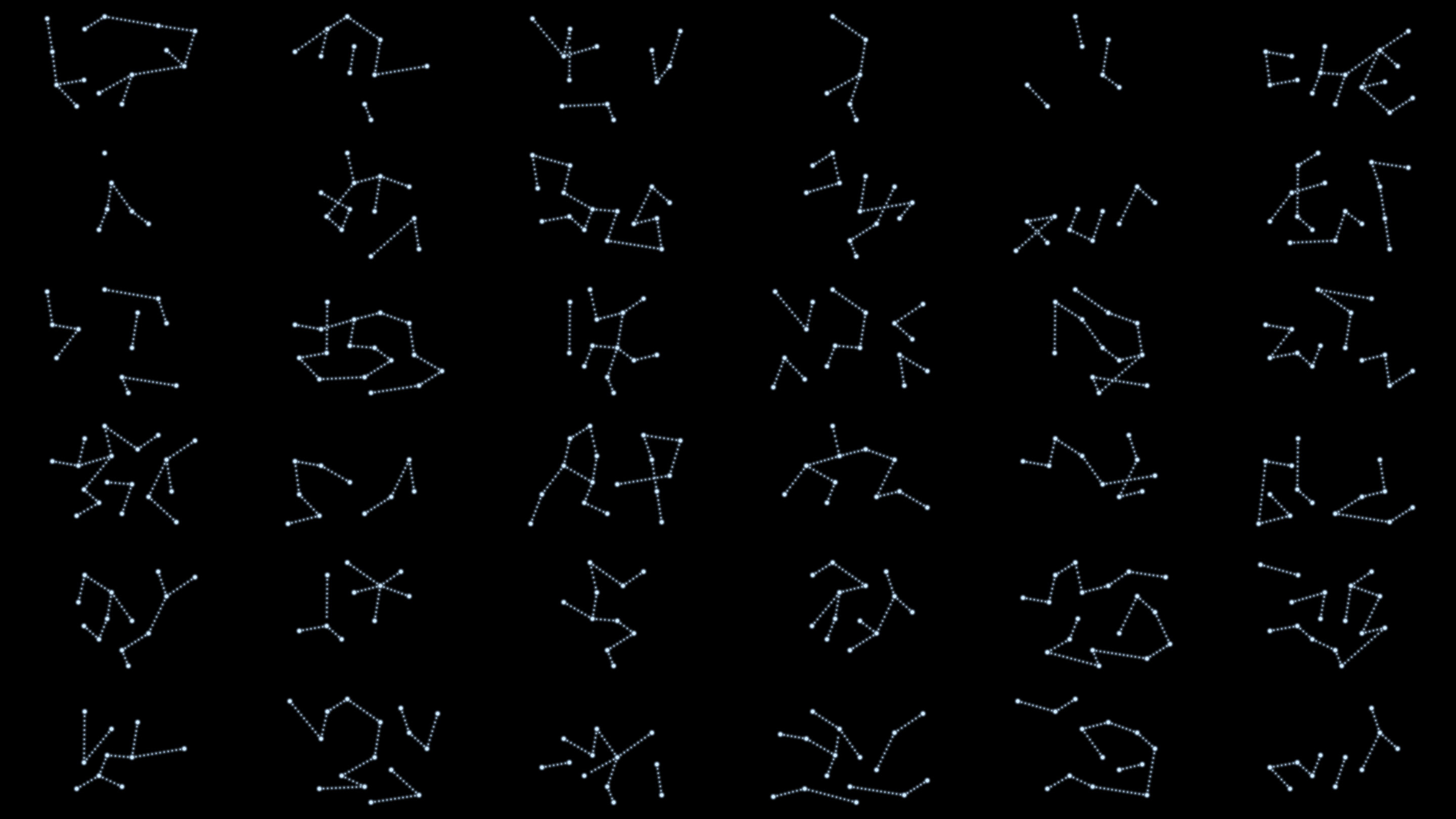
And Milky Way glyphs:

Also visible here are the "superglyph" all the Pegasus glyphs are derived from, and two new Pegasus glyphs I've made as point-of-origin symbols using the superglyph. If I knew something about programing or scripting, it seems like it would be possible to make a simple program that would generate random symbols from the superglyph, so I could have a selection of potential origin symbols. But, I don't, so I'll just make them as I need them.
I went back to the actual constellations the Milky Way symbols are based on, though I tried to also keep them consistent with the original symbols (some of the connections made on the stargate symbols aren't the official lines drawn in the constellations). For some of symbols that were very different from the IAU depictions, I relied on this piece of production art, which helpfully compares the symbols as-drawn with the actual star patterns. -
David's Stargate 3D Stuff
I banked everything up, and now I have way, way too much to cram into one forum post. The SG-1 'gate is now finished, and all the details are up on my website. And I mean everything, we've got the model download, we've got orthos, we've got detail and lighting showcase renders in 5k, we've got turnaround videos, we've got dialing animations, we've got an entire separate blog post on how dialing works. It's nuts!
But, you're busy people, so here are some highlights so you don't have to click through.
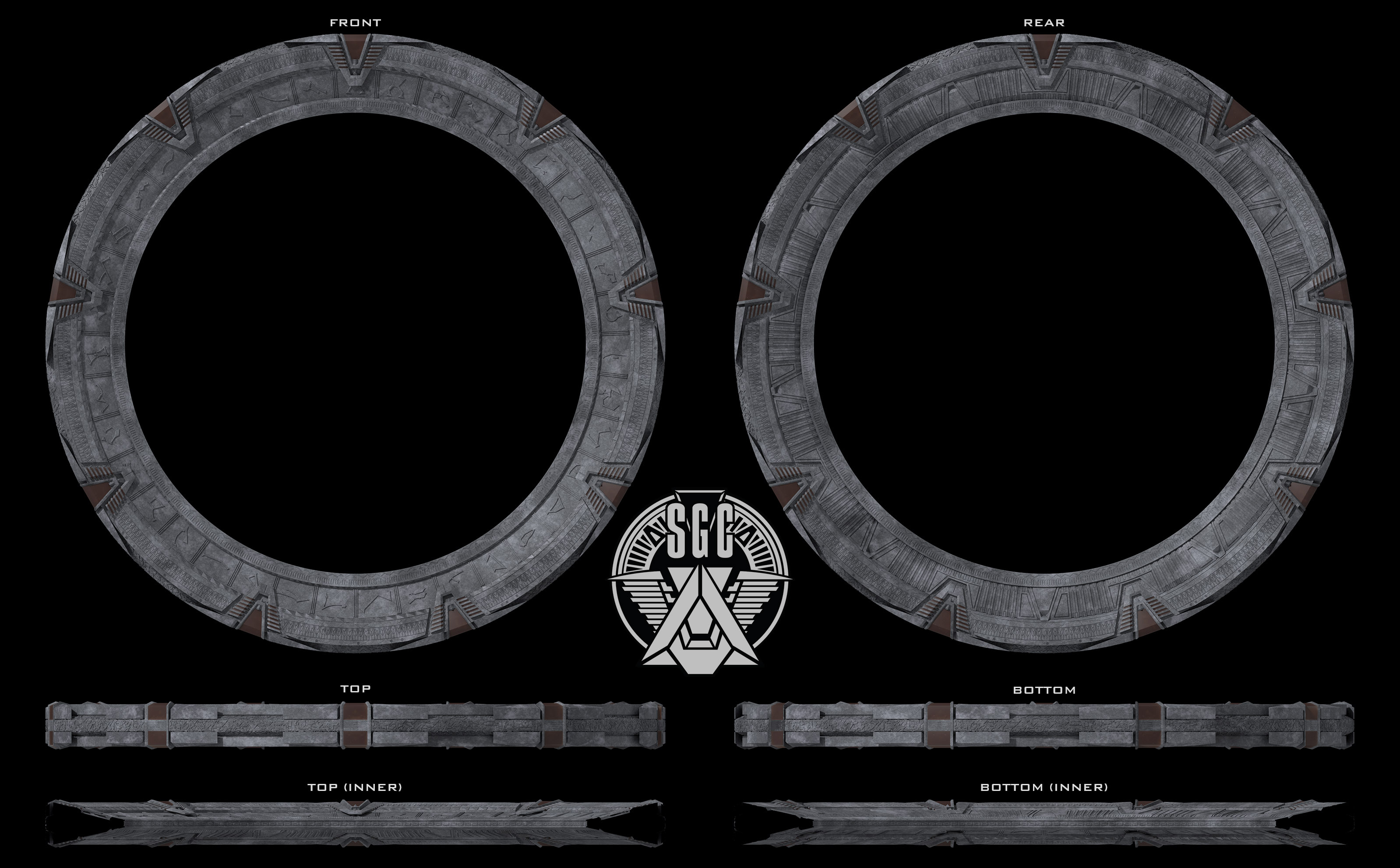
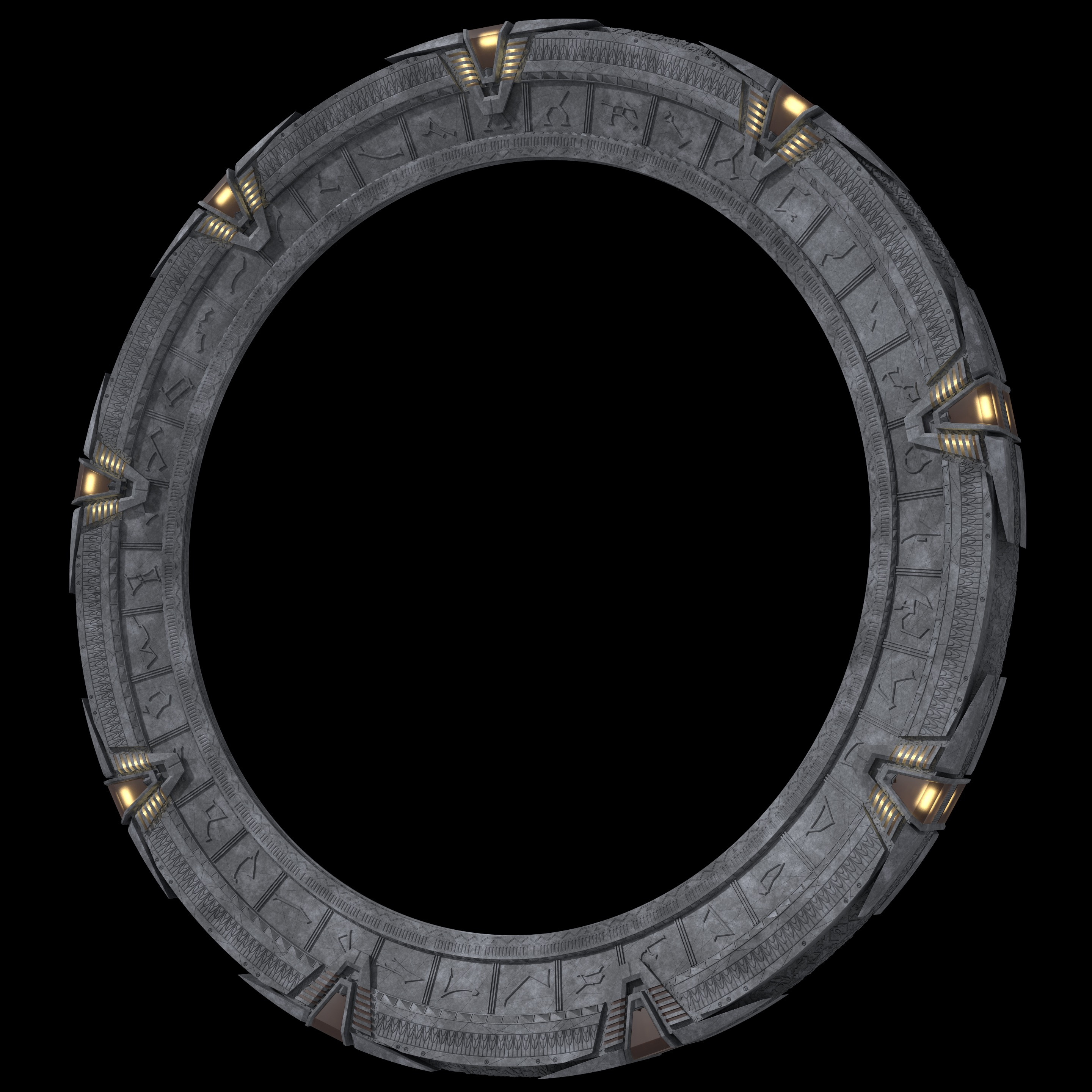

I was not kidding about how strongly I feel about origin symbols. -
David's Stargate 3D Stuff
Hi everybody, I'm David. You might know me from various other forums and websites, I've been around the scene on and off for a while. I may be a little set in my ways, but I've decided that, like they say, the best time to start posting on SFM is yesterday, the next best time is today, so, let's get this show on the road.
There was a flurry of interest in Stargate SG-1 last summer during lockdown on another board I visit, and my first big 3D project as a young modeler was the stargate, which I redid a couple years later. I'd been thinking about making a third version pretty much since I finished the second version, and kept my eye out as reference material continued to appear, especially production diagrams put up for auction after the shows ended, and the goldmine of high-res photos from the Enfants de Mac Gyver fan group building a full-scale replica stargate based on original parts. While I was doing research and noticing a lot more subtleties and differences that I'd missed before, I decided on a plan of attack; I'd initially build with an eye towards making the movie and SG-1 versions, since they're mostly identical. The Atlantis version actually has a number of major differences, so I'd start that one after completing the movie/SG-1 gate, pulling out whatever parts and segments I could reuse.
I've just finished modeling and texturing the movie version of the stargate. As part of the project, I did something I don't think anyone else had ever attempted, and recreated the alternate set of symbols seen on the stargate on Abydos in the movie, before the series retconned that each stargate had only one unique symbol representing itself, and the 38 address symbols are standardized. Here are some orthos of the movie version of the model.
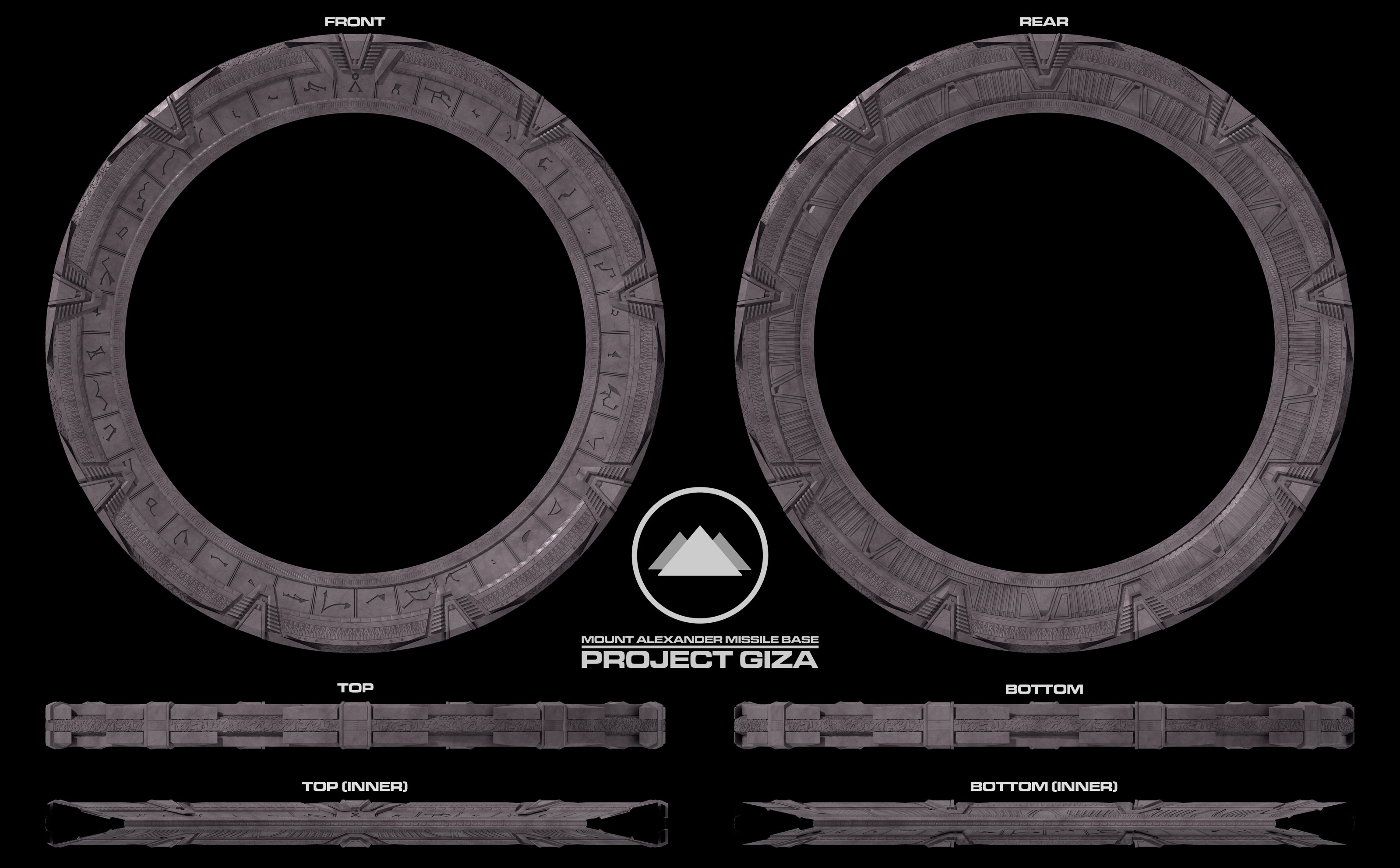
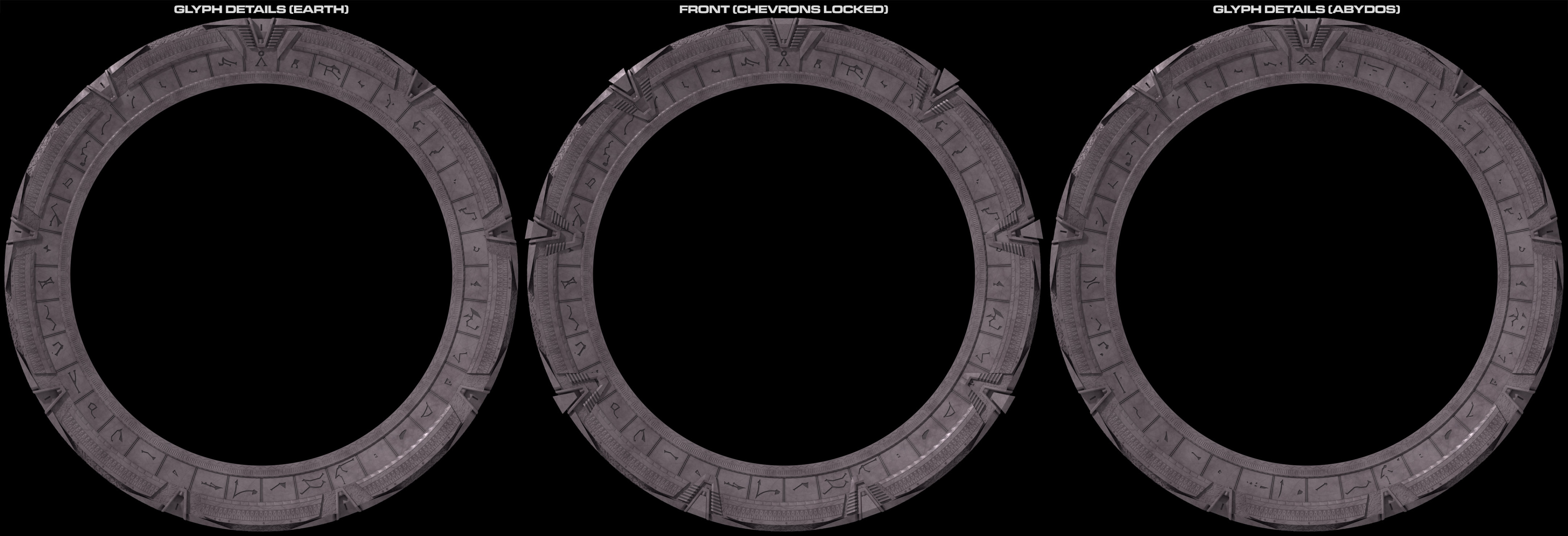
There are many more images, as well as a link to a lighting test turntable animation (I don't see an option to embed video here?) on my website.
I've started working on the inner ring for the SG-1 version of the model (in addition to being extruded instead of engraved, every symbol was redrawn for the series, so they're all a different size or a different shape than the ones I made for the movie version). I'm also planning to create a number of different inner rings to represent different stargates, each with its own point-of-origin symbol. Aside from the handful of canon origin symbols from the show (Earth, Abydos, Earth's second stargate, and the virtual reality planet), most of the ones seen just reused an address symbol. For those, I'm planning to use the corresponding symbol from the Abydos movie stargate. I'm also on the hunt for any other origin symbols, from games, comic books, novels, I'll even take other fan-art. So far, the only one I know of is that the upcoming Stargate tabletop RPG designed a symbol for the "Phoenix Site" off-world base's stargate, but if anyone else knows of any, I'd love a heads-up. -
David's Stargate 3D Stuff
First off, my model has already been put to good use in the wild. Dinosaur artist antediluviananimals has 3D printed a stargate model based on my new version, converted into the Atlantis version with parts from my older version, and H. Keith Hamilton is using it in an animation he's making to show fan interest in a new Stargate show.
Work has been continuing on the Atlantis version of the Stargate which, it turns out, is almost entirely different from the SG-1/Movie version. Glass half full, I already know how to attack building the model, glass half empty, I have to make essentially the same model over again from scratch.
In these renders, you can already see several of the differences. For instance, the cross-section is different, the original gate is pinched on the inner edge, while the Atlantis version has a constant slope all the way down, so the inner rim is twice as wide (with two rows of emitter details), and also doesn't have the "lip" around it, but is flat from front to back. The chevrons sit higher up (actually a change from the movie to the SG-1 version, but I kept the movie arrangement in my SG-1 model because it aligned better). The "pills" and zig-zag lines on the inner edge, and the arches above the inner ring are aligned on a 711-segment radial division, rather than the 666-segment (spooky!) division. The patterns are also different (and you can't see it, but the front and back are rotated differently, with the half-height zig-zag point pointing vertically on the back). The grooves around the pills have extra cuts joining them with the circles that separate the groups of pills.
I've just finished the mosaic tiles around the rim and in the slots the chevrons fit into. The mosaic tiles were much easier to trace out on this version of the gate, both due to their repetitiveness (the front and back sides are identical, and the pattern repeats three times on every segment) and due to a couple of extremely-clear reference photos. Unfortunately, while the chevron slot pattern is both symmetrical and identical on the front and back, there are no clear images of the bottom half of the rear slot (the part that's covered up by the glyph track on the front of the 'gate), so I had to make an educated guess based on what little I could make out. Not that it's visible in these images, since I haven't done any of the parts on the back yet.
Next up, the rear inner ring.
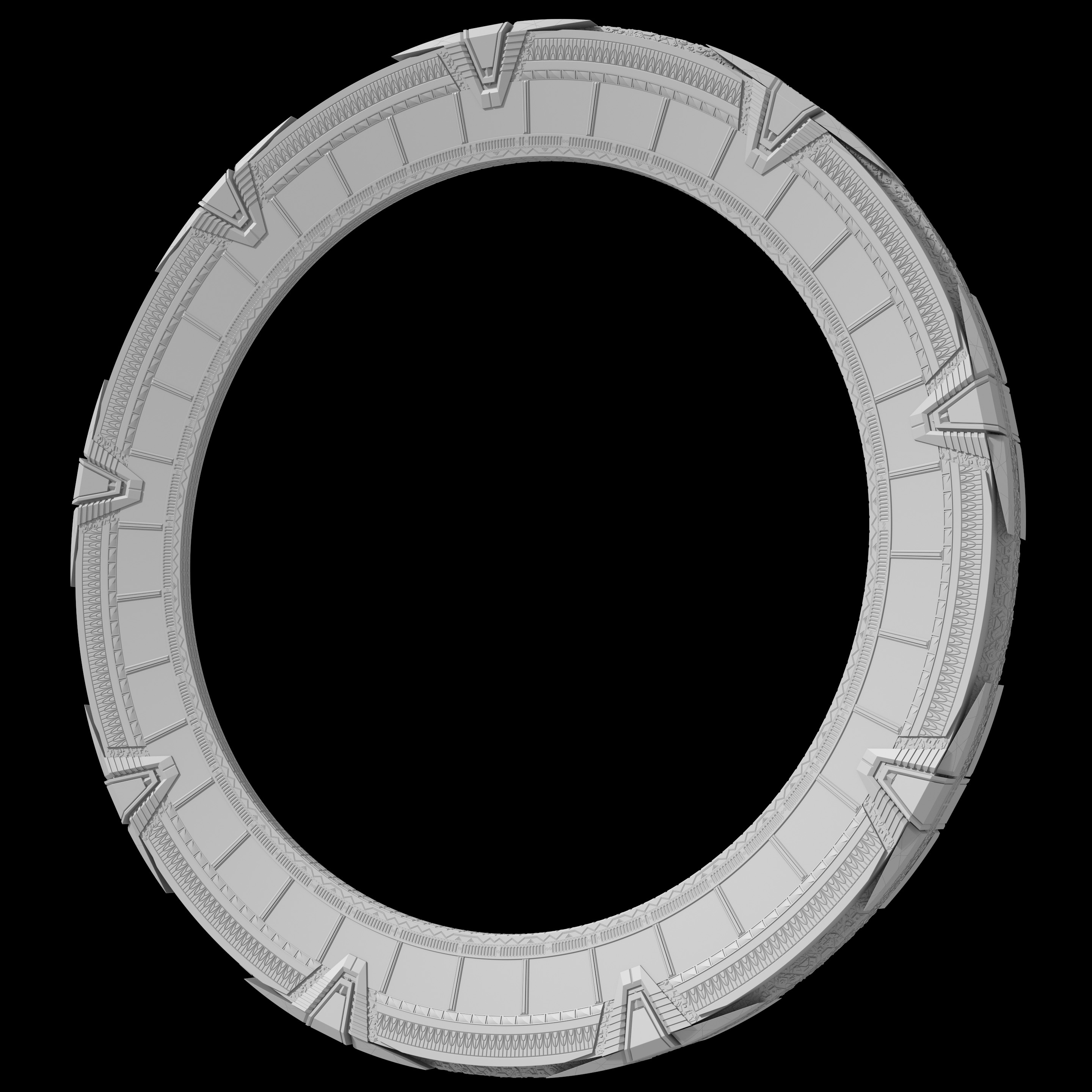
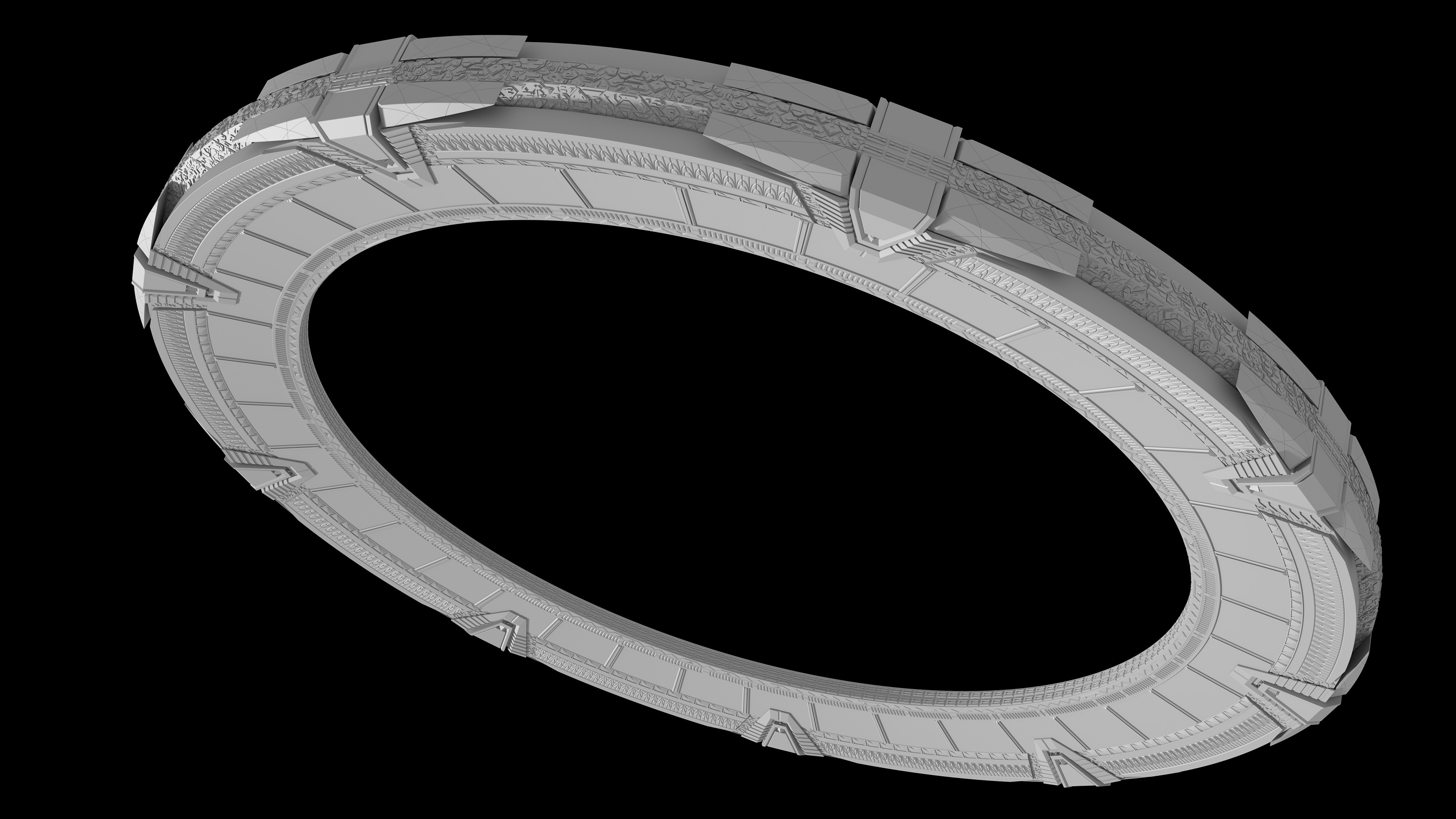
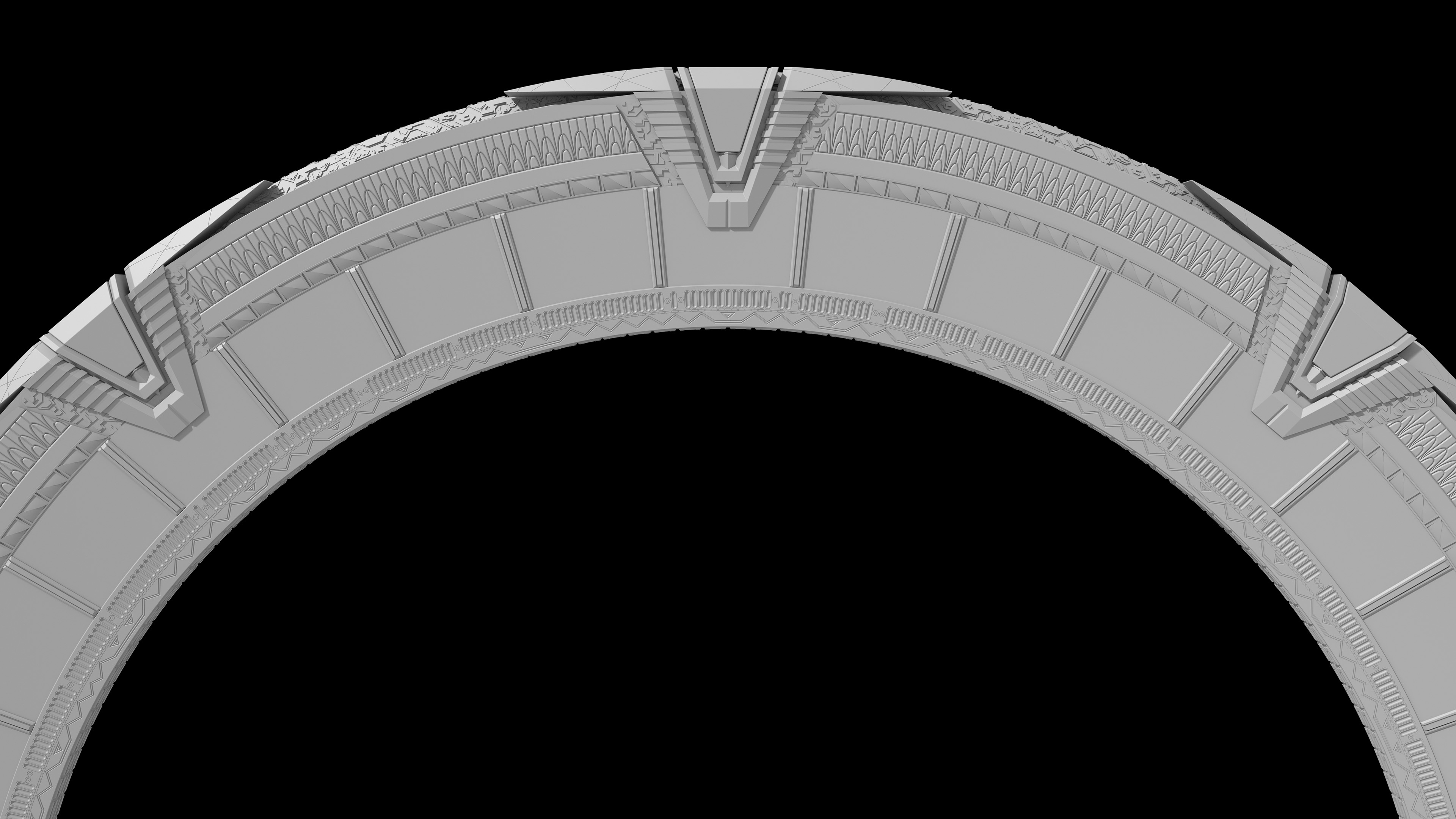
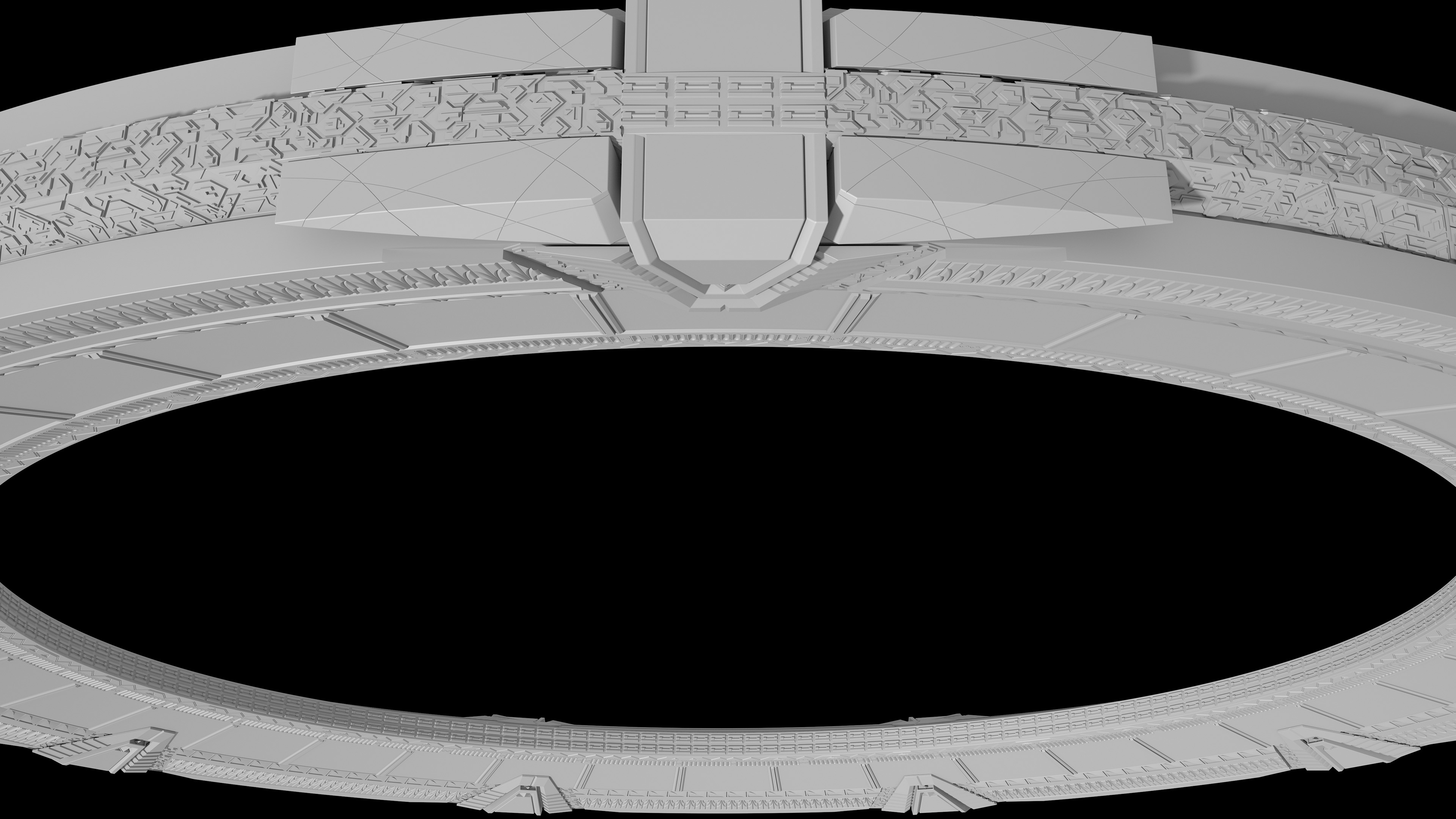
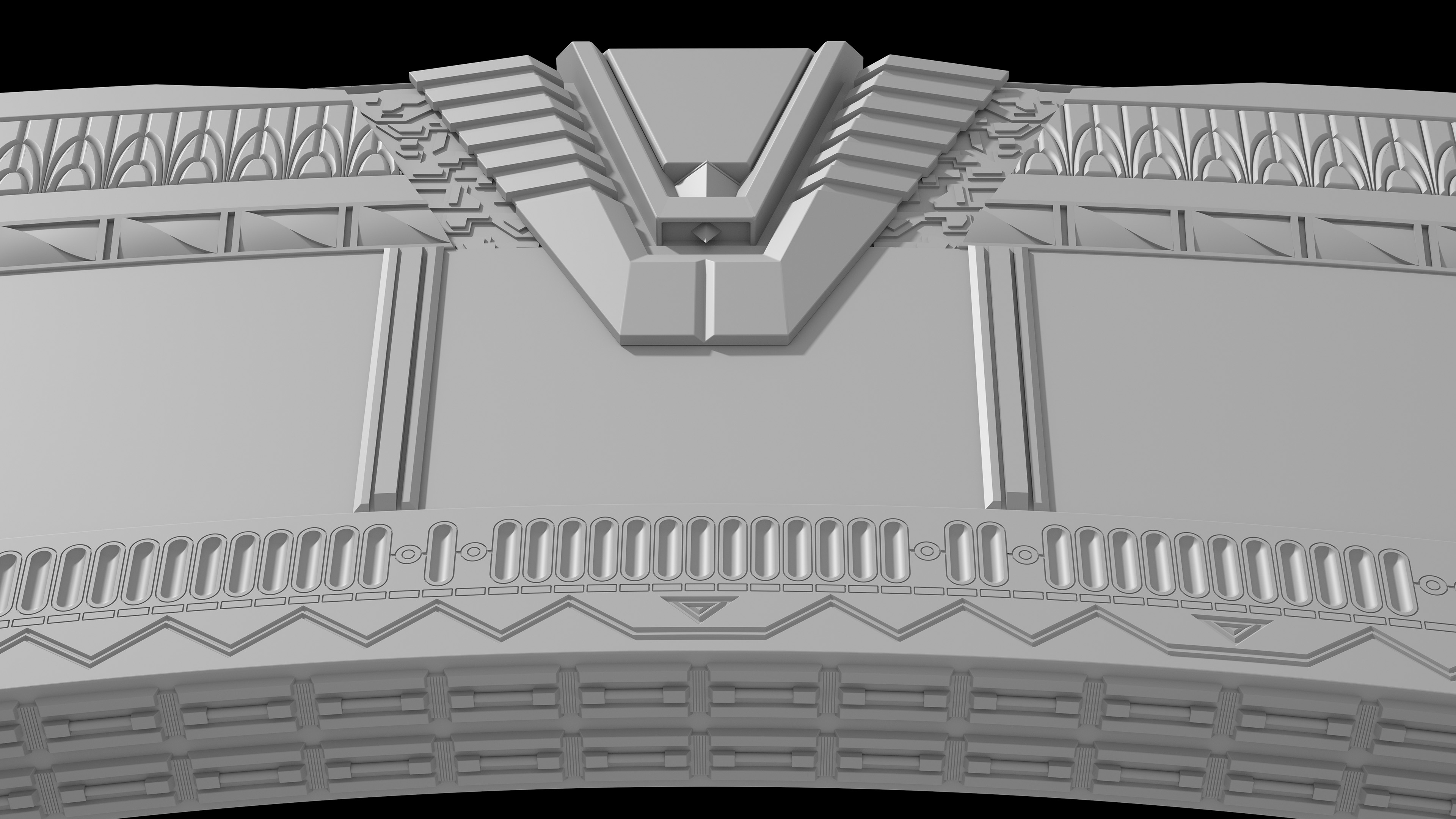
-
David's Stargate 3D Stuff

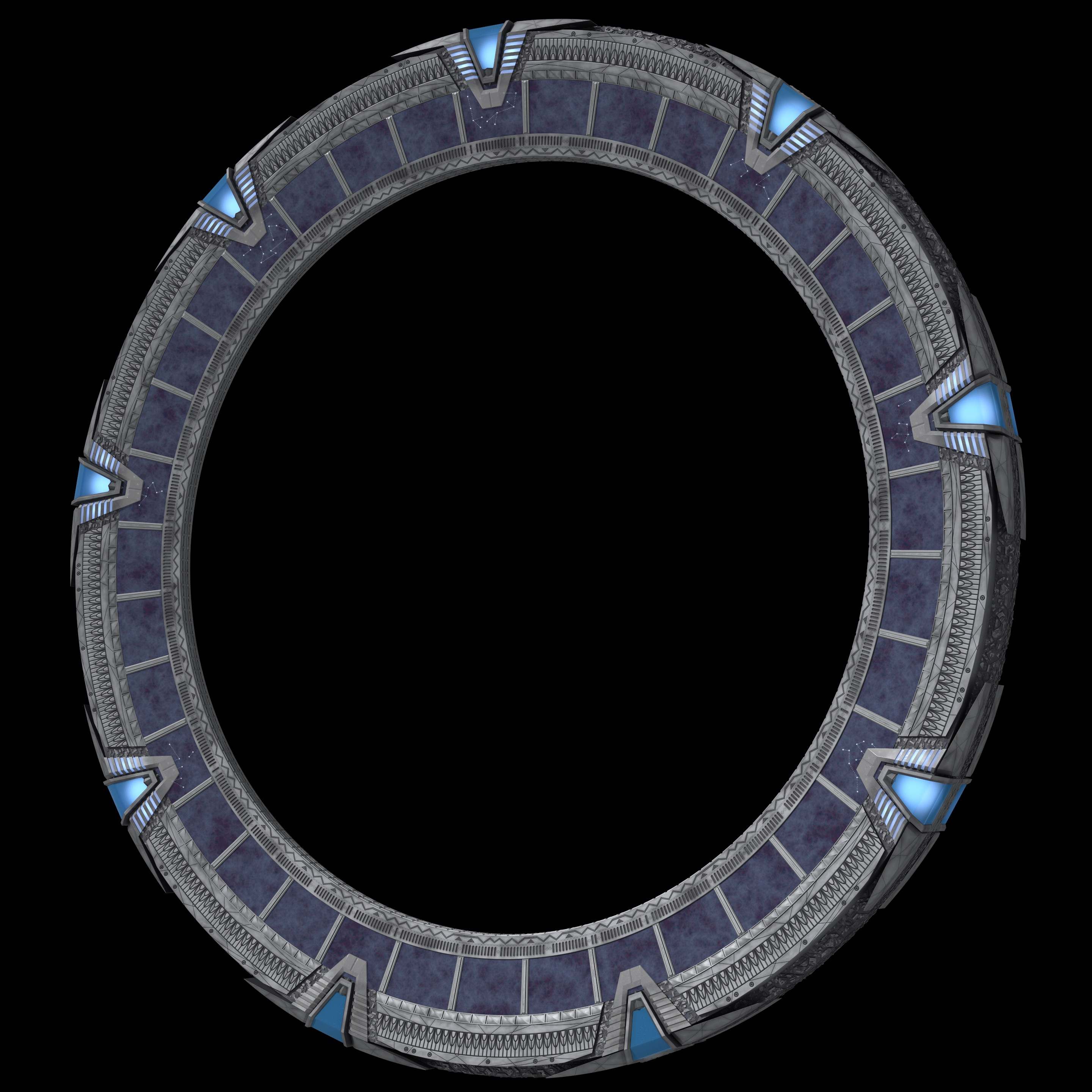
I haven't quite finished all my lighting and animation demo renders yet, but I couldn't wait any longer to get this out into the world. The Pegasus Stargate is now up for download on my website, in Lightwave, FBX, and OBJ formats.
My computers will be tied up doing the rest of the rendering for a little bit, but once I get the chance, I'll be diving in (so to speak) with the puddle effect. I'm looking forward to using some of the features that didn't exist in Lightwave last time I tried to make it. -
David's Stargate 3D Stuff
Thanks for the origin symbols, I threw them in with the others I made.
I'm about finished with the SG-1 gate, though I'm still running the lighting-test animation for that version, so I'm holding off on putting together all the images to post before it's done. I've also got some housekeeping I want to finish up, rigging the model for animation and packaging it for download, but hopefully I'll be able to get all that done over the next week.
I did do a little quicky side project the other evening, the SGC logo plaque from the briefing room. Joseph Mallozzi, who was a writer and producer on the TV shows, has been posting high-res behind-the-scenes photos, concept art, and documents since the shows were still on the air, and recently posted a construction diagram of the plaque, which made it pretty easy to model in only an hour or two, most of which was spent squinting at the measurements and comparing with some photos of the finished plaque to see how things changed between the drawing and the actual piece.
There was also a 3D rendered version used on the show as a screensaver and decorative element on computer displays which was colored differently, so I made both versions. I didn't sweat getting the textures exactly right (and there were some shape differences with the digital version I didn't bother changing), just going for the spirt instead of a perfect duplicate. The gaudy '90s texturing is pretty rough, and now we've entered a glorious era where flat colored in CGI actually look okay.

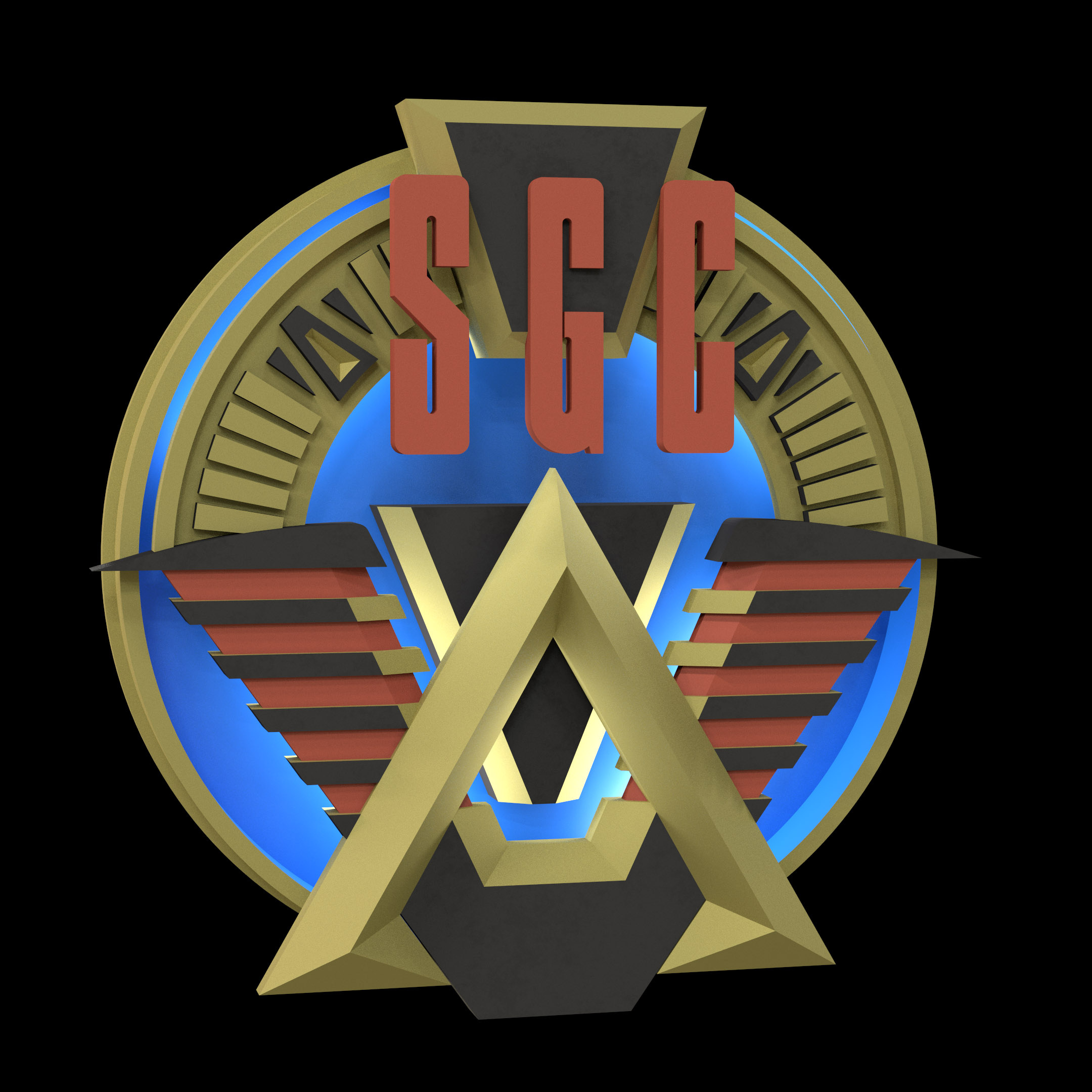
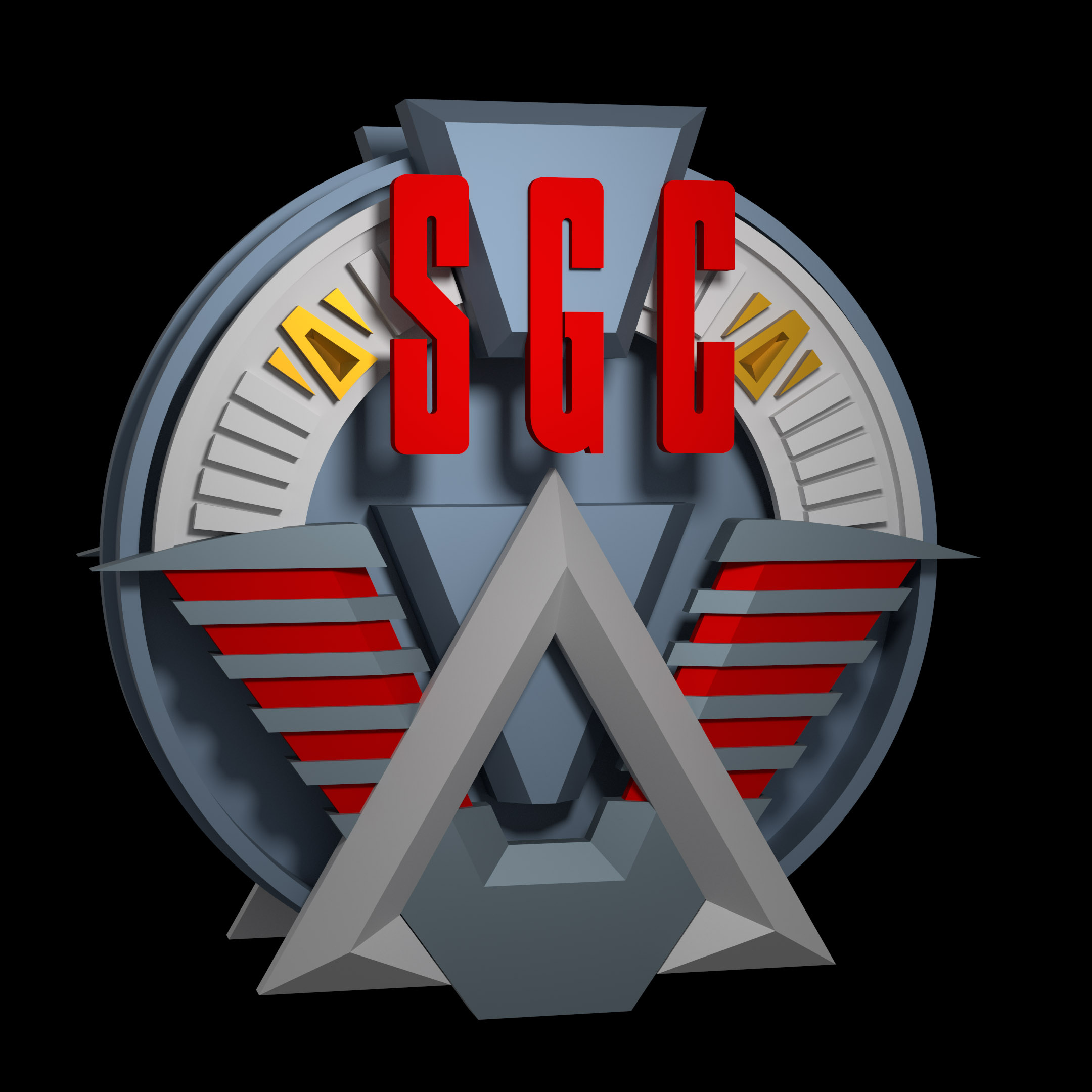

-
David's Stargate 3D Stuff
Had a bit of a slowdown thanks to computer trouble I could no longer forestall after a few hectic... years... and the release of Myst VR (and some subsequent light data-mining), but now I'm back with a spiffy new machine.
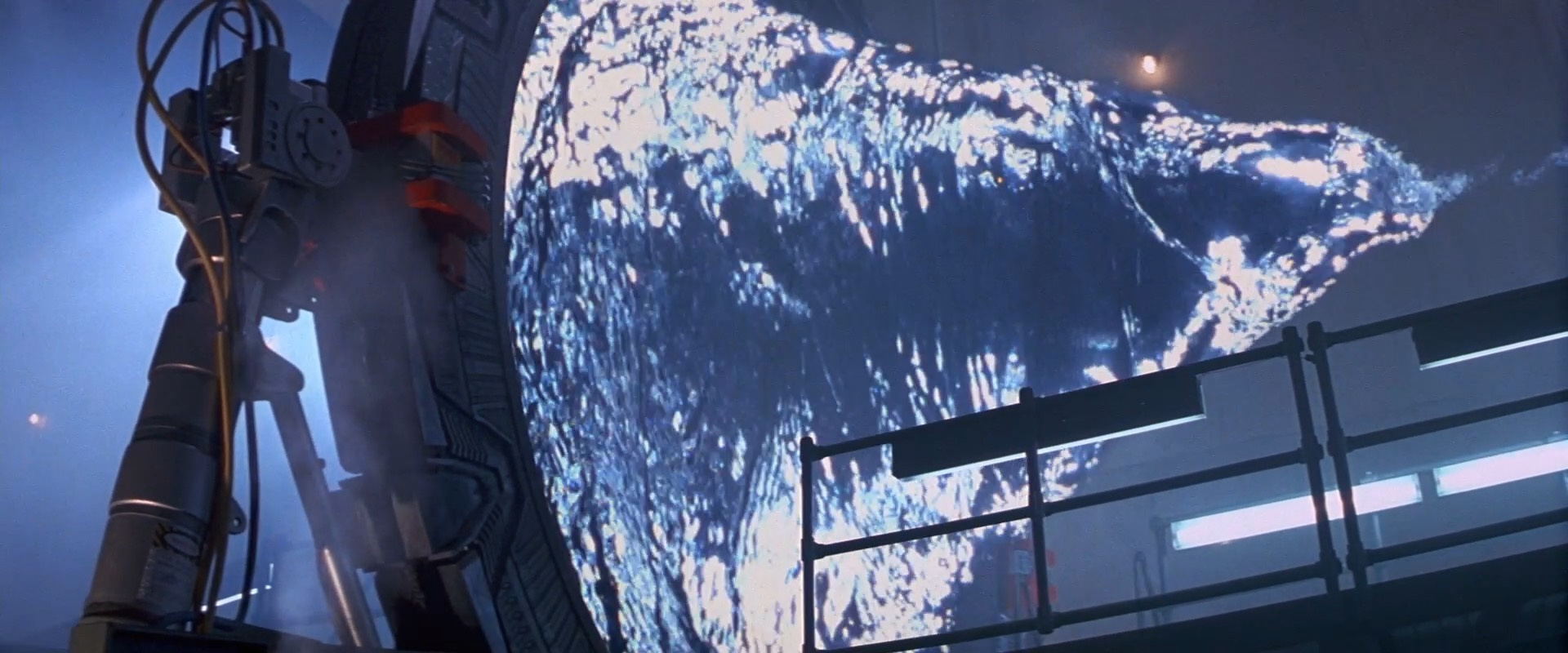
First, for reference, the strudel as it appeared in the movie.
And what I've come up with:
It's extremely straightforward. The surfacing is based on what I did for the front of the puddle, with the light refractions faked with gradient shaders remapping the same procedurals that are driving the bump mapping that's pulling actual scene reflections, though, in the case, I used a Crumple and a couple of Cyclone procedurals. Why two Cyclones? Because they don't animate and I though it was too obvious the swirls weren't moving, and overlaying a second on rotating helped. A bit.
The funnel itself is nothing fancy, just a curvy cone with procedural deformations (and an alpha map so that it doesn't deform where it's touching the stargate. The cavitating bubbles gave me some trouble. I tried a particle emitter, but it wouldn't swirl. I tried some dummy objects with mostly-transparent noise textures, but that didn't work. What I settled on was a trail of single-point polygons, with the pixel-size set to a negative so they'd render as tiny spheres instead of points. They were textured with a transparency and a bit of a glow starting at the tail of the vortex then quickly fading down, with a series of procedural clip maps that helps give them the illusion of motion as they pop in and out. I might want to add some more points to get it a little fuzzier, but I feel like the better solution is to just let film grain and bloom settle them in on the real renders.
So, to the kawoosh. I have three ideas for how to do it.
The classic way would be a series of morph targets. I think if I arrange my edge loops right and have enough intermediary morphs, I can get something that gets a little bit of the billowing of the actual effect. I'm not sure how it'll look (at best, probably a lot like this), but the benefit is that I know exactly how to do it on a technical level.
The second idea was to use dynamics. Have a disc object, and use a proxy sphere to punch it outward like a sheet of rubber. I've used Bullet before, but just for colliding objects, not for deformations like that. I did a quick mess-around, but I have not figured out how to make my disc stretchy yet.
The third idea is to use fluids. At first I thought this was doomed to failure; the tricky part about the kawoosh is that it's a negative space, it's not water exploding outward, it's air pushing out water and then the water returning to level. I was thinking that all I would end up would be basically a mold for a kawoosh, all the space around it that isn't part of the shape I want. But I've realized, air is also a fluid, so I would think it should be possible to have my simulated water tank, hit it with a blast of simulated air, and then save and render the solve for the air being blasted into the water and pushed back out. I did walk through LWGuru's video, but it'll take a lot more practice before I really have a sense for this. And my first attempts at running the fluid simulations was painfully slow, even at a lower resolution on my new computer, so I'll need to figure that out, too. -
David's Stargate 3D Stuff
I continued tweaking the puddle until I was satisfied (and then tweaked it again after it occurred to me that to clip out all the scenes of the effect in the movie so I could see what it was doing for more than a second at a time, at which I realized that it was an overlay of two sets ripples, one expanding outward and and the other retracting inward). Since I've had no joy on getting caustics to do anything in 2020, I exported the puddle object as a LWO2 and loaded it into 2015, where I'm rendering a loop of the caustic lighting, which I'll apply as a projection map to a spotlight. There are pros and cons (pro, the lighting actually looks like real water, con, it won't respond if the ripple pattern changes, neutral, the original didn't respond either, because it was just light reflected off of crinkling mylar), but I'm ready to declare victory unless someone cracks the case of how to make a swimming-pool floor effect in LW2020 (it's the example they use to explain what caustics are in the manual, for crying out loud!).
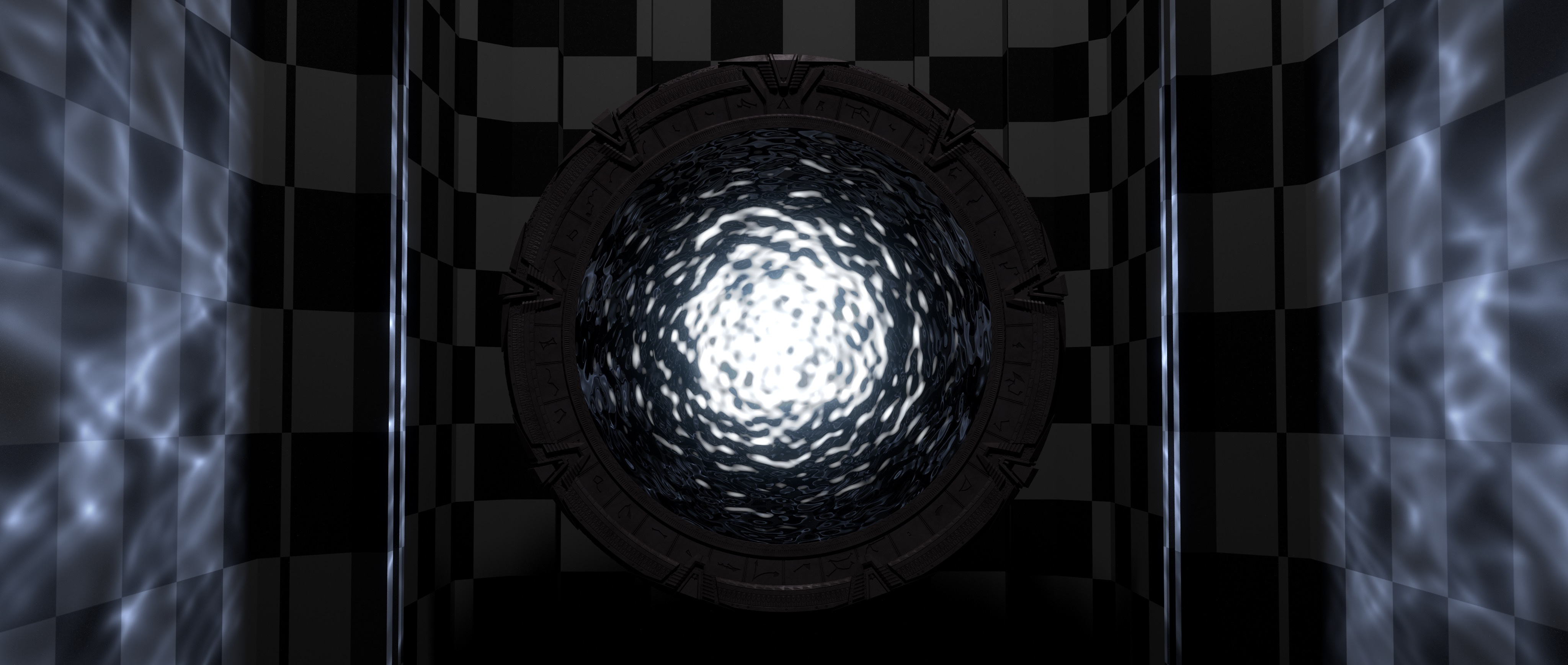
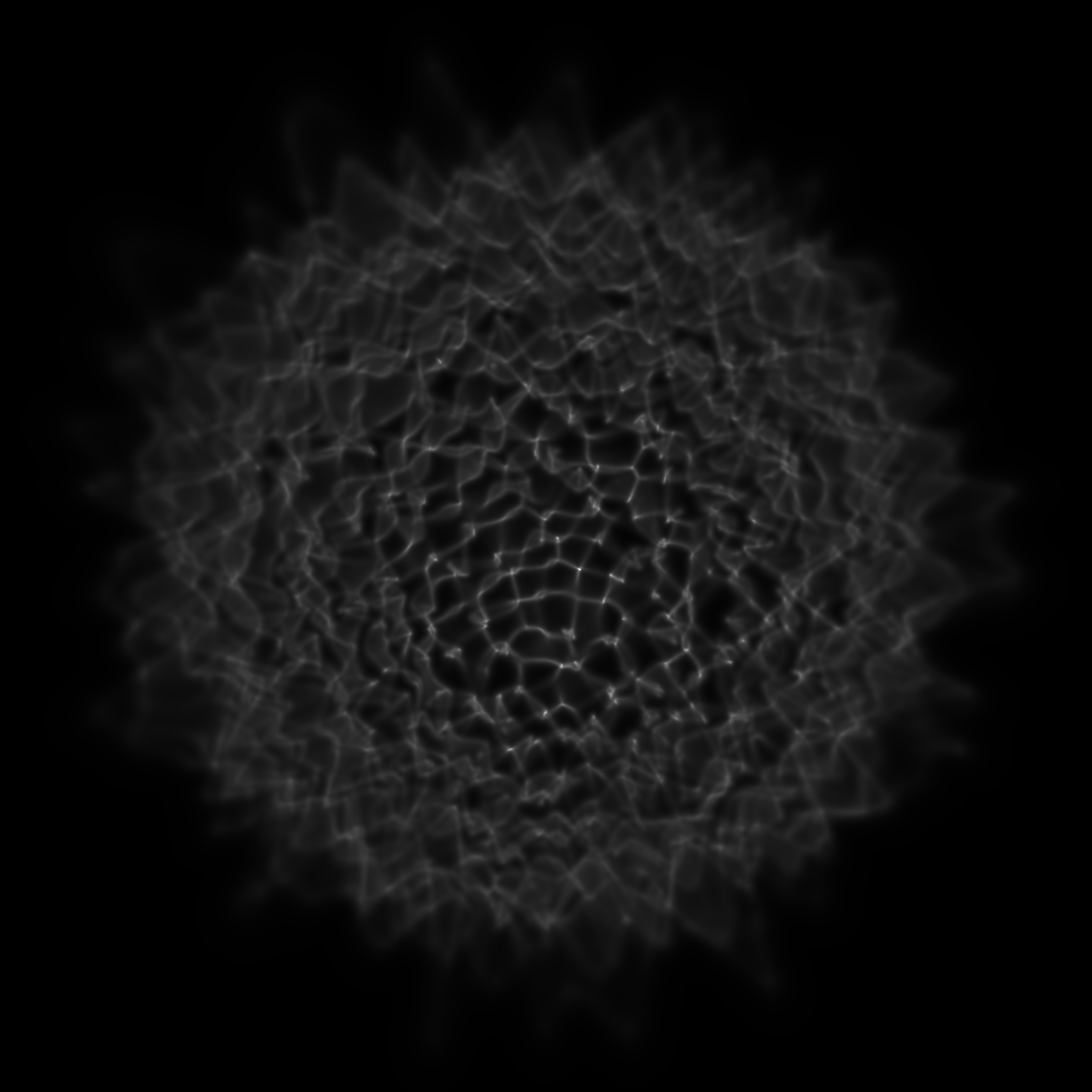
Next up is the strudel extending out the back, the forming/dissipating effect of the puddle (the movie version is just a slightly fancy radial dissolve), and then I start playing with fluids, dynamics, cloth, volumetric, morphs, and whatever else it takes to get a decent kawoosh.
Additional credits
- Icons from Font-Awesome
- Additional icons by Mickael Bonfill
- Banner background from Toptal Subtle Patterns
© Scifi-Meshes.com 2001-2024

